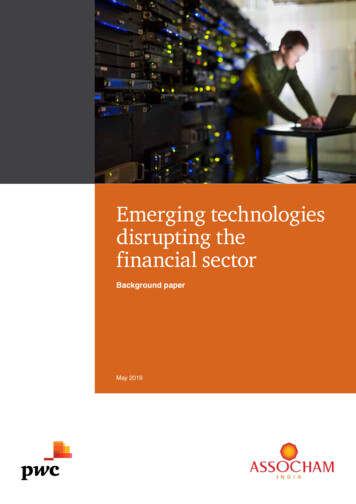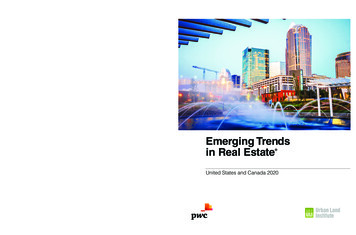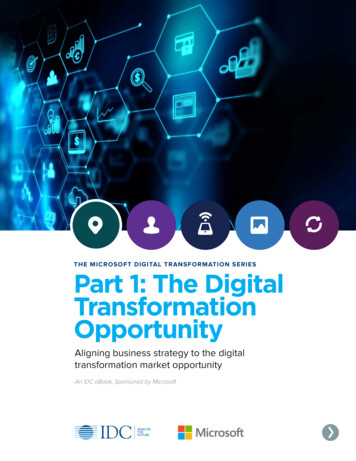
Transcription
Emerging technologiesdisrupting thefinancial sectorBackground paperMay 2019
Message from PwCthe wealth management space, as digital advisory models aim todemocratise investment management for the mass segment.Vivek BelgaviAshootosh ChandPartner, FS Tech andIndia FinTech Leader,PwC IndiaPartner, Emerging Technologies,PwC IndiaOver the last five years, the Indian FinTech market has scaled newheights, both in terms of funding received and the increasing consumeradoption of FinTech solutions. In 2018, India ranked second globallyon FinTech adoption, with its percentage of FinTech users at 57.9%.Although India’s adoption rate lags behind China’s 83.5%, it hassurpassed that of developed countries, which stands at 34.2%.1Several favourable factors have aligned to effect this. First, consumerexperiences have been transformed by non-Financial Services (FS)tech firms, leading to rising digital expectations from FS providers.Second, the Indian Government and regulators have engendered anenabling environment for FinTechs by launching several initiativesaimed at augmenting the country’s digital infrastructure and boostingthe application programming interface (API) economy. Third, advancedtechnologies such as artificial intelligence (AI) and cloud computinghave empowered organisations to ride the data explosion wave, fuelledby rising mobile and Internet penetration, to derive business insights.The interplay of these factors, coupled with the low penetration ofFS in India, has enabled innovators to reconfigure FS value chainsby offering best-in-breed point solutions, primarily aimed at enrichingcustomers’ experience and driving operational efficiency.In the Indian FinTech space, digital payments and alternative lendingsegments have led from the front in turbocharging the industry’sgrowth, followed by the emerging areas of InsurTech and WealthTech.The digital payments space, in particular, is witnessing remarkableinnovations such as the emergence of alternative payment channels,setting up of payments hubs and tokenisation for securing payments.Along similar lines, alternative lenders are leveraging advancedtechnologies and employing innovative business models to reshapethe lending value chain from customer acquisition and credit scoring toloan servicing and recovery. For the Indian insurance industry, the ultralow levels of insurance penetration (2.76% in life insurance and 0.93%in non-life insurance)2, coupled with the technology-led innovations thatare underway across the product, pricing and distribution spectrums,make it ripe for digital disruption. Similar trends are shaping up inDespite the tremendous progress made by Indian FinTechs, their truedemocratic potential is yet to be fully exploited, as current solutionsprimarily cater to the affluent, urban segments and not the masses.However, we believe this is set to change, as the next wave of FinTechgrowth is likely to be led by the bundling of FinTech solutions withthe rising consumption needs of this segment on the back of theirincreasing income levels. For FS players, targeting a core consumerneed (not necessarily financial) and expanding along a continuum ofadjacent offerings to provide FS solutions at the point of consumptionwould positon them to monetise this large user base, and drivefinancial inclusion.Another overarching theme manifesting itself in the FS space isthe increasing number of partnerships between various playersacross industries. The diverse Indian digital payments landscapetoday, including telecom companies, banks, wallet companies andretailers (e-commerce), drives home this point. Similarly, FS lendersare increasingly partnering with alternative data providers such asFinTechs, data utilities, and tech players to cater to the evolving needsof today’s marketplace. Clearly, the industry has come to realise thatthe true power of FinTech lies in collaboration. However, within thisoverall trend, another significant theme playing out is the increasingrole of non-FS players who leverage their captive customer baseand superior technology stack to own the customer experience,upending the product distribution space. This has huge implicationsfor incumbents, as profit streams begin to shift from productmanufacturing to other value chain activities that directly control thecustomer experience. Going forward, incumbents would need to makestrategic bets on where to play in the FS value chain, as platformisationbecomes the new normal in the FS industry.The next five years hold immense potential for both FinTechs andincumbents to revolutionise the FS landscape and uplift India’seconomy by driving the consumption story. However, success inthis digital economy would be dictated by an organisation’s capacityto innovate, along with its ability to manage partnerships andorchestrate ecosystems across both FS and non-FS players toprovide financial solutions at the point of consumption. Ultimately,this would boil down to how effectively organisations can build digitalleadership and business agility to drive the organisational change andthe cultural mindset shift required for embracing innovation and newways of working.Through this report, we have articulated some key trends in theIndian FinTech landscape by setting them against the technologicaladvancements disrupting the FS space, and have providedrecommendations for furthering India’s FinTech growth.1 Academy of Internet Finance, Zhejiang University; Sinai Lab; Cambridge Centre for Alternative Finance and Zhejiang Association of Internet Finance. (2018). TheFuture of Finance is Emerging: New Hubs, New Landscapes: Global Fintech Hub Report. Retrieved fromhttps://www.jbs.cam.ac.uk/fileadmin/user ads/2018-ccaf-global-fintech-hub-report-eng.pdf (last accessed onMay 10, 2019)2 The Insurance Regulatory and Development Authority of India (IRDAI). (2019). Annual Report 2017-18. Retrieved from https://www.irdai.gov.in/ADMINCMS/cms/frmGeneral NoYearList.aspx?DF AR&mid 11.1 (last accessed on May 05, 2019)2PwC - ASSOCHAM Emerging technologies disrupting the financial sector
Message from ASSOCHAMBalkrishan GoenkaPresidentASSOCHAMEmerging technologies have reshaped the financial services industrythrough innovative means to cater to evolving customer expectationsof personalisation and convenience.solutions in the country. These include building the digitalinfrastructure by creation of Unified Payments Interface (UPI)based ecosystem to boost payment transactions, makinghigh-speed internet available at low costs, increasing smartphonepenetration and many more.FinTech has evolved as one of the most innovative and cost-effectivedisruptive technologies. Early adaptation of FinTech solutions hasenabled several start-ups, financial service providers and otherdiverse sectors to achieve an accelerated pace of growth.To address the key issues, opportunities and challenges in India’sFinTech market, ASSOCHAM has organised the summit with thetheme, “Emerging Technologies Disrupting the Financial Sector”.The summit provides an opportunity for open discussions on thefuture of financial services which continues to be influenced bynew innovative technologies and digitisation.Over the last several years, the Indian FinTech market has beenon a growth trajectory, as is evident from an increase in both thenumber of FinTech companies founded and the investments theyhas attracted. From January 2013 to October 2018, a total of 1994FinTech companies have been founded, turning into a hotbed ofentrepreneurial activity. With a strong tech ecosystem as its backboneand a huge market base coupled with the growth of formal FinancialServices (FS), the Indian FinTech market offers immense potential.I wish ASSOCHAM and PwC Team all the success.Balkrishan GoenkaThe Indian Government and market regulators have played afavourable role in accelerating the growth and adoption of FinTech3PwC - ASSOCHAM Emerging technologies disrupting the financial sector
Message from ASSOCHAMSaurabh SanyalDeputy Secretary GeneralASSOCHAM2018 emerged as a phenomenal year for the FinTech sectoras global funding scaled new heights on the back of supportiveregulatory policies, technological advancements and risingconsumer adoption of FinTech solutions.As per an industry report, global VC-backed funding in FinTechcompanies touched USD 39.57 billion across 1707 deals, botha new annual high. This was partly driven by 52 mega-rounds(USD 100 million ) totalling USD 24.88 billion, indicating investors’increasing appetite for larger deals and preference for investing inlate-stage companies, as the funding market matures.The Indian FinTech market has also been on a growth trajectory,evidenced by an increase in both the number of FinTech companiesfounded and the investment they have attracted. From Jan 20134PwC - ASSOCHAM Emerging technologies disrupting the financial sectorto Oct 2018, a total of 1994 FinTech companies have been founded,turning India into a hotbed of entrepreneurial activity. With a strongtech ecosystem as its backbone and a huge market base with lowpenetration of formal financial services (FS), the Indian FinTech marketoffers immense potential.To address the key issues, opportunities and challenges in India’sFinTech market, ASSOCHAM with PwC as the Knowledge Partnerhas organised this FINTECH SUMMIT with the theme of “EmergingTechnologies disrupting the Financial Sector”.I wish the Summit all the success.Saurabh Sanyal
Contents1. Overview of the Indian FinTech market71.1. Sustained funding powering the global and Indian FinTech story91.2. Key drivers of India’s FinTech revolution131.3. Segment overview161.3.1. Digital payment171.3.2. Alternative lending241.3.3. InsurTech281.3.4. WealthTech291.4. The consumer-need cornerstone: Building offerings around a core consumer need to drive business growth301.4.1. Gauging the opportunity: Bundling FinTech with the consumption needs of the mass segment301.4.2. Realising the opportunity: The consumer need cornerstone framework311.5. Challenges faced by the FinTech ecosystem322. Emerging technologies reshaping the financial services (FS) sector332.1. Redefining customer experience using modern technology342.2. Managing risk with AI/ML352.3. Moving from robotic process automation (RPA) to intelligent automation (IA)372.4. Technologies shaking up the FS infrastructure392.4.1. Blockchain moving into the mainstream392.4.2. Building and innovating on cloud402.5. Cyber security422.6. The way forward443. Recommendations for accelerating FinTech growth545PwC - ASSOCHAM Emerging technologies disrupting the financial sector
6PwC - ASSOCHAM Emerging technologies disrupting the financial sector
1Overview of theIndian FinTechmarket7PwC - ASSOCHAM Emerging technologies disrupting the financial sector
The Indian FinTech market has been on an upward growthtrajectory over the last five years. This is evidenced by an increasein both the number of FinTech companies founded and theinvestment they have attracted. From January 2013 to October2018, approximately 2,000 FinTech companies have been founded,turning India into a hotbed of entrepreneurial activity (Figure 1).3This has also translated into increased consumer adoption ofFinTech solutions. In 2018, India ranked second globally in theFinTech adoption rate. The average percentage of FinTech usersin the country is 57.9%, behind China’s 83.5%, and much higherthan developed countries’ 34.2%.4 With a strong technologicalecosystem as its backbone and a huge market base with a lowpenetration of financial services (FS), the Indian FinTech marketholds immense potential.Figure 1: Entrepreneurial activity on the rise in IndiaY-o-Y number of FinTech companies founded (2013 - 2018*)574CAGR - 15.64%9.825.4920192023Source: Statista, 2019This report comprises three sections. Section 1 provides anoverview of the Indian FinTech landscape by exploring theunderlying factors driving its growth, key FinTech segments,and challenges faced by the FinTech ecosystem. Section2 focusses on the key ‘emerging technological’ trends thatare transforming the FS sector, and section 3 presents ourrecommendations for furthering India’s FinTech growth story.524337293Figure 3: Global FinTech transaction value projections, 2019 2023 (USD trillion)20066201320142015201620172018*Source: Tracxn, 2018Note: 2018 data is till October 2018The overall transaction value in the Indian FinTech market is estimatedto jump from approximately USD 66.1 billion in 2019 to USD 137.8billion in 2023, growing at a CAGR of 20.18% (Figure 2).5 The globalFinTech market is also poised to achieve high growth levels in thecoming years. The overall transaction value in the global FinTechmarket is predicted to grow from around USD 5.49 trillion in 2019 toUSD 9.82 trillion in 2023, a CAGR of 15.64% (Figure 3).6Figure 2: India FinTech transaction value projections, 2019 to2023 (USD billion)CAGR - 20.18%137.866.120192023Source: Statista, 20193 Tracxn. (2018). Feed Report - FinTech India Oct 2018. (last accessed on May 10, 2019)4 Academy of Internet Finance, Zhejiang University; Sinai Lab; Cambridge Centre for Alternative Finance and Zhejiang Association of Internet Finance. (2018). TheFuture of Finance is Emerging: New Hubs, New Landscapes: Global Fintech Hub Report. Retrieved fromhttps://www.jbs.cam.ac.uk/fileadmin/user ads/2018-ccaf-global-fintech-hub-report-eng.pdf (last accessed onMay 10, 2019)5 Statista. (2019). Fintech India outlook. Retrieved from ndia (last accessed on May 10, 2019)6 Statista. (2019). Fintech worldwide outlook. Retrieved from orldwide (last accessed on May 10, 2019)8PwC - ASSOCHAM Emerging technologies disrupting the financial sector
Sustained funding powering theglobal and Indian FinTech storyreport, global venture capital (VC)-backed funding in FinTechcompanies rose to approximately USD 39.57 billion across 1,707deals, both of which represent a new annual high (Figure 4).This was partially driven by 52 mega-rounds (USD 100 million )totalling USD 24.88 billion, indicating investors’ increasing appetitefor larger deals and the preference for investing in late-stagecompanies as the funding market matures.72018 emerged as a phenomenal year for the FinTech sector,as global funding broke new ground on the back of supportiveregulatory policies, technological advancements and an increasein consumers’ adoption of FinTech solutions. As per a CB InsightsFigure 4: Global FinTech funding hits a record high in 2018Global VC-backed FinTech funding and deal count, 2014 - 2018 (USD 720142015201620172018Funding (USD bn)Deal countSource: CB Insights, 20197 CB Insights. (2019). 2019 Fintech Trends To Watch. Retrieved from -trends-2019/ (last accessed on May 4, 2019)9PwC - ASSOCHAM Emerging technologies disrupting the financial sector
This exceptional growth in global funding was primarily drivenby the North American and Asian markets, as deal activityincreased across all continents, barring Europe (Figure 7). TheUS retained top positon, with 659 deals totalling approximatelyUSD 11.89 billion, an annual high both in terms of the numberand size of deals. However, Asia, driven by China and India,remains well-positioned to unseat North America as the primarymarket for global funding. This is corroborated by its ascendancyin recent years (Figures 5 and 6), despite the US imposingregulatory barriers on investment in China in 2018. Asia attractedthe largest chunk of VC-backed FinTech funding - USD 22.64billion across 516 deals – during the year. This figure includesthe most significant funding deal of approximately USD 14 billionin a Chinese FinTech. Aggressive growth strategies adopted byChinese technological giants and their expansion into new marketslike Southeast Asia and India played a key role in driving globalfunding to Asia. Another significant development in 2018 was theglobal nature of FinTech’s growth, with 39% of deals being closedoutside the core markets of the US, UK and China, signalling theincreasing potential of emerging markets such as India.Figure 5: Asia emerges as the largest FinTech target market for funding in 2018Global VC-backed FinTech funding by target market % share, 2018Europe8.91%North lia0.87%South America1.36%Global VC backed FinTech investments in 2018USD 39.57 billion across 1707 dealsSource: CB Insights, 2019Figure 6: Asia’s rising share in global FinTech fundingGlobal VC-backed FinTech funding by continent, 2014 - 2018 (USD 8.676.2620152016North AmericaAsiaSource: CB Insights, 2019106.26.84PwC - ASSOCHAM Emerging technologies disrupting the financial sector2017Europe12.412018
Figure 7: Deal activity increases in 2018 across continents, barring EuropeGlobal VC-backed FinTech deal count by continent, 234144201420152016North America2017Asia2018EuropeSource: CB Insights, 2019Note: Other continents not included in the graph11PwC - ASSOCHAM Emerging technologies disrupting the financial sector
Robust funding landscape in IndiaIn line with the global trends, sustained VC-backed investmentsin the Indian FinTech space over the last few years have playeda pivotal role in propelling India’s FinTech sector. In 2018, Indiareceived approximately USD 1.79 billion8 in VC-backed fundingacross 97 deals. Though this was an annual high in terms of dealcount, it reflected a decline from the record funding of USD 2.4billion across 48 deals in 2017 (Figure 8).9Figure 8: India FinTech deal count doubles in 2018 to 97 from48 in 2017India VC-backed FinTech funding and deal count, 2014 – Q1 ’19(USD 01620172018Q1'19Funding (USD mn)Deal countSource: CB Insights, 2019; Tracxn. 2018In addition, India overtook China as Asia’s top FinTech fundingtarget market with investments of around USD 286 million across29 deals, as compared to China’s USD 192.1 million across 29deals in Q1 2019 (Figure 9). The massive slump witnessed byChina in this quarter could partly be attributed to its Government’sconcerted efforts to rein in the risks associated with themushrooming of its peer-to-peer (P2P) lenders.108 CB Insights. (2019). Global Fintech Report Q1 2019. Retrieved from -trends-q1-2019/ (last accessedon May 04, 2019)9 Tracxn. (2018). Feed Report –FinTech India Oct 2018. (last accessed on May04, 2019)10 CB Insights. (2019). Global Fintech Report Q1 2019. Retrieved from -trends-q1-2019/ (last accessedon May 05, 2019)12PwC - ASSOCHAM Emerging technologies disrupting the financial sector
Figure 9: India overtakes China in FinTech funding in Q1 2019 and ties up with China in FinTech deal count in Q1, 2019VC-backed FinTech deal count in India and China (USD million),Q1 2019VC-backed FinTech deal count in India and China (USD million),Q1 : CB Insights, 2019Source: CB Insights, 2019Though the Indian FinTech market has witnessed high levels ofinvestment activity in recent years, a quick comparison with coreFinTech markets like the US and China reveals that India stillhas substantial headroom for further growth. Some of the factorssupporting the Indian FinTech market are examined in the nextsection.Changing consumer demographics,evolving needs and rising digitalexpectationsFinTech solutions are being created to cater to the evolving needs ofthe young Indian consumer with a median age of 28.2 years.11 Theseconsumers are tech-savvy, spend considerable time (approximately130 minutes per day for premium segment users)12 on theirsmartphones and are open to accessing financial products on digitalplatforms. In addition, FS players have to match consumers’ risingappetites for digitisation, with the bar for customer experience set highby the non-FS technology players.Key drivers of India’s FinTechrevolutionIn India, along with sustained funding, both supply-side factorssuch as Government and regulatory support, and technologicaladvancements and demand-side factors such as large unmetneeds and rising customer digital expectations have beenconverging to drive the FinTech market. These factors arediscussed below.All these factors have led to FS players offering digital services,forcing incumbents to rethink their business models and collaboratewith start-ups, or offer services through their own digital platforms.Government policies, regulations andinfrastructureUnmet financial needsThe Indian Government and regulators have played a prominent rolein accelerating the growth of FinTech solutions across the country bylaunching several initiatives to this end. Some of these key initiativescan be categorised below:A large portion of the Indian population has been excluded fromthe formal financial system, owing to multiple reasons such as lackof awareness about the benefits of FS products and the inabilityof traditional FS players to serve this segment in a cost-effectivemanner. However, since the launch of schemes like Jan DhanYojana and Direct Benefit Transfer, there has been a marked risein awareness levels of FS products. The traditionally unbankedand underbanked population, that was earlier averse to accessingformal FS products, is now embracing them. However, theincumbents have been unable to meet their requirements. Thishas paved the way for FinTechs to serve this segment across thecountry with their low-cost and digitised products.Driving financial inclusionGoods and Services Tax (GST) regime: The introduction of the GST regime has been a key step informalising the unorganised sector of the Indian economy, withmany FinTechs leveraging the digital footprint generated fromthe Goods and Services Tax Network (GSTN). The networkhas 1.21 crore registered taxpayers13 to credit score and lendto micro, small and medium enterprises (MSMEs)11 Statista. (2019). India: Average age of the population from 1950 to 2050 (median age in years). Retrieved from ge-of-the-population-in-india/ (last accessed on April 29, 2019)12 Nielsen. (2018). Average Indian smartphone user spends 4x time on online activities as compared to offline activities. Retrieved .html (lastaccessed on April 29, 2019)13 Goods and Services Tax Network (GSTN). (2019). GST system statistics. Retrieved from https://www.gstn.org/ (last accessed on April 08, 2019)13PwC - ASSOCHAM Emerging technologies disrupting the financial sector
Jan Dhan Yojana:Availability of the internet A flagship initiative of the Government, this scheme aims todrive financial inclusion across the country. This has resulted ina significant uptick in the number of people with bank accountsin India (approximately 320 million accounts were opened underthe scheme),14 laying the foundation for the delivery of bankingservices to the unbanked. The scheme has also brought in abehavioural change among unbanked consumers. This, in turn,has led to an increase in the demand for FS products, therebycreating viable opportunities for FinTechs. Over the last decade, there has been a significant rise in access toand speed of the internet (approximately 520 million mobile internetusers16) across the country (Figure 11). This is a prerequisite froman infrastructural standpoint to access FinTech services. In addition,the cost of internet usage has dropped significantly in the past fiveyears, resulting in an increase in the number of internet users. This,in turn, contributes to FinTech adoption.Building the digital infrastructureUnified Payments Interface (UPI):Figure 11: Number of mobile internet users crosses the 500million markNumber of mobile and internet users in India1.18 billion The launch of UPI by the National Payments Corporationof India (NPCI) has resulted in the roll-out of interoperablepayment services amongst FinTechs and incumbent institutions,leading to the widespread adoption of digital payments acrossmerchants and customers. The platform was used by 92 banksand witnessed 620 million transactions worth INR 1 trillionin December 2018 (Figure 10), making it one of the largestpayment platforms across the world.15 In addition, the launchof UPI 2.0 with an overdraft facility in 2019 has the potential toenable credit access to many thin-file customers.Mobile subscribers540 millionInternet users520 millionMobile internet usersFigure 10: UPI transactions cross INR 1 trillion in valuein Dec 2018Growth of the UPI platformSource: PwC analysisNovember2016December20182192No. of bankson UPINo. ofTransactionson UPI0.3millionValue ofTransactionson UPI0.9billionINR620million1TrillionINRSource: PwC analysisDigital India programme The Government’s push to improve digital literacy across thecountry through a bouquet of initiatives spanning infrastructure,literacy and ease of accessing digital services has had asignificant impact in improving the overall digital maturity ofthe Indian populace. These initiatives have led to increasedawareness about FinTech solutions, thus boosting their usage.Promoting innovation and competitionin the industryStartup India The flagship scheme of the Government to promote the effortsof startups in the country by providing regulatory and financialsupport which has led to a growth in the number of FinTechstartups in the country.Licence for payment banks The RBI has issued licenses to 11 FinTech companies to offere-banking services like remittances, deposits and savings,paving the way for new-age branchless banking services offeredby FinTechs.Recognition of peer-to-peer (P2P) lenders as non-bankingfinancial companies (NBFCs) The RBI provided legitimacy to the P2P lending segment bycategorising them as NBFCs, boosting the sector’s growth.14 Moneycontrol. (2018). Close to 32 crore bank accounts opened under Jan DhanYojana post 2014. Retrieved dhan-yojana-2696161.html (last accessed on May08, 2019)15 Kumar, S. (2019, Feb 19). Making it cashless and how: UPI in 2018 and beyond.Inc42. Retrieved -and-how-upi-in-2018-andbeyond/, (last accessed on May 8, 2019)16 (2019, March 20). India’s telecom subscribers base crosses 120 crore: Trai data.Livemint. Retrieved -data-1553093994494.html(last accessed on May 8, 2019)14PwC - ASSOCHAM Emerging technologies disrupting the financial sector
FinTech players symbiotically increase their presence through thedistribution infrastructure of incumbents.Regulatory sandbox by the RBI for FinTechs The RBI has planned to set up a regulatory sandbox for FinTechstart-ups, and the norms for the same are expected to beannounced by June 2019. The central bank aims to achievea middle ground between innovation and regulation to helpthe FinTech industry achieve its potential. The sandbox isexpected to provide temporarily relaxed regulatory norms for theconceptualisation of new solutions or products on a small scalebefore a potential scale up. This is a first-of-its-kind initiativeby the regulator in India and is expected to provide a boost toorganisations and start-ups that wish to enter the industry.In general, the methods of collaboration can be summarised asbelow: Supplementary offerings: Using new or existing subsidiariesor sub-brands to offer new services Partnerships: Developing joint solutions with FinTechs Acquisitions: Enhancing their services by acquiring FinTechs Incubators: Launching incubators to promote startups relevantto their marketIn recent years, some state governments have also joined thecentral Government in driving the FinTech agenda, with theMaharashtra and Andhra Pradesh Governments setting up aMumbai FinTech Hub and FinTech Valley in Vizag, respectively, forstrengthening the FinTech ecosystem in their states. Invest: Setting up venture funds to invest in FinTechsHowever, the road to collaboration is not free from obstacles.Differences in the work culture, business models and securitycontinue to pose key challenges. While incumbents struggle withthe pace of innovation and the rigidity of their legacy systems,startups face legal, bureaucratic and cultural issues while workingwith institutions. Despite these challenges, collaboration hasbecome a highly promising avenue for growth and is expected toremain so in the future, leading to increased adoption of FinTechsolutions among consumers.Rising collaboration betweenincumbents and FinTechsIn the context of the compete-vs-collaborate debate, the increasingtrust in the FS ecosystem has brought incumbents and FinTechplayers together to explore more opportunities for collaboration.These partnerships have led to innovative customer propositionsand new revenue streams - industry incumbents adopt technologyand innovation in a more seamless and rapid cycle, while15PwC - ASSOCHAM Emerging technologies disrupting the financial sector
Segment overviewThe Indian FinTech market has seen the emergence of a fewdominant segments that are disrupting the FS value chainby offering technology-led innovations to improve customerexperience and engagement, and to drive operational efficiency.Within this space, digital payments and alternative
Over the last five years, the Indian FinTech market has scaled new heights, both in terms of funding received and the increasing consumer adoption of FinTech solutions. In 2018, India ranked second globally on FinTech adoption, with its percentage of FinTech users at 57.9%. Althoug










